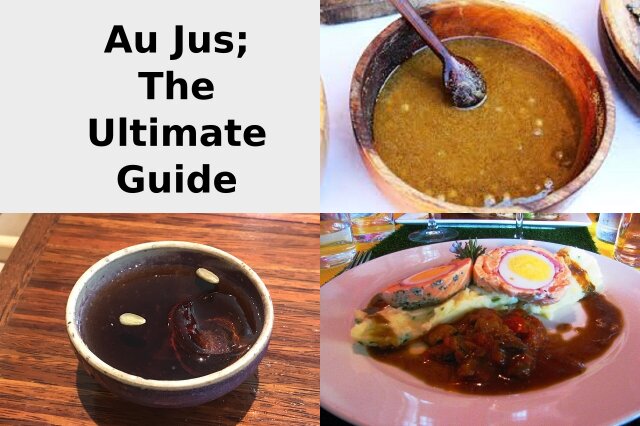In French, “au jus” translates literally to “with the juice.” It refers specifically to a culinary technique and dish where meat is cooked in its own juices, creating a light and flavourful broth or gravy.
This natural sauce enhances the meat’s flavour and adds moisture to the dish, making it a classic accompaniment to roast beef, prime rib, and other succulent cuts.
So, next time you encounter “au jus” on a menu, remember it’s not just a fancy way to say “with gravy” – it’s a celebration of the meat’s own delicious essence!
In this guide, we’ll explore the history and uses of au jus, as well as provide a simple recipe for making it at home.
What is Au Jus? A Comprehensive Guide
 From its origins to its uses in modern cuisine, this guide covers all aspects of au jus.
From its origins to its uses in modern cuisine, this guide covers all aspects of au jus.
Discover the definition and how to make it at home!
What is Au Jus?
Au jus is a French term that literally means “with juice.”
It refers to a thin, flavourful sauce made from the natural juices of meat, typically beef or lamb.
The sauce is often served alongside the meat as a dipping sauce, adding extra flavour and moisture to the dish.
While au jus is most commonly associated with French cuisine, it is now used in a variety of dishes around the world.
In this guide, we’ll explore the history and uses of au jus, as well as provide a simple recipe for making it at home.
The Origins of Au Jus.
The origins of au jus can be traced back to France in the 19th century.
It was originally served as a sauce for roasted beef, with the natural juices of the meat being used to create the flavourful sauce.
Over time, the use of au jus spread to other meats, such as lamb and pork, and it became a staple in French cuisine.
Today, au jus is used in a variety of dishes around the world, from sandwiches to soups to gravies.
Au Jus vs Gravy: What’s the Difference?
While both au jus and gravy are used as sauces for meats, there are some key differences between the two.
Au jus is made from the natural juices of the meat, while gravy is typically made from a roux (a mixture of flour and fat) and broth or stock.
Au jus is thinner and more flavourful, while gravy is thicker and often used to add moisture to drier meats.
Additionally, au jus is typically served on the side, while gravy is often poured over the meat.
Uses of Au Jus in Modern Cuisine.
Au jus has become a popular addition to many modern dishes, adding a rich and savoury flavour to a variety of meals.
It is commonly used as a dipping sauce for sandwiches, such as French dip or roast beef sandwiches.
It can also be used as a sauce for steaks, pork chops, and other meats.
Some chefs even use it as a base for soups and stews, adding depth and complexity to the dish. With its versatility and delicious flavour, au jus is a staple in many kitchens around the world.
8 of The Best Dishes to Serve with Au Jus
Whether you’re serving roast beef or prime rib, au jus is the perfect accompaniment.
Check out these 8 mouth-watering ideas that will take your meal to the next level.
- Mashed Potato;
Drizzle the sauce over the mashed potato.The combination of creamy mashed potatoes with au jus because the creaminess of the potatoes complements the savoury and rich flavour of the au jus.
Additionally, the texture of the mashed potatoes can provide a nice contrast to the thin and liquid consistency of the au jus.
- French Dip Sandwiches;
The classic pairing for au jus is a French Dip sandwich.Thinly sliced roast beef is piled high on a crusty baguette and served with a side of warm au jus for dipping.
It’s a hearty and satisfying meal that’s perfect for lunch or dinner.
- Prime Rib;
Prime rib is a decadent and delicious cut of beef that pairs perfectly with au jus.The rich, juicy meat is enhanced by the savoury flavour of the au jus, making for a truly indulgent meal.
- Beef Tenderloin;
Beef tenderloin is a lean and tender cut of meat that’s perfect for special occasions.Serve it with a side of au jus for added flavour and moisture.
- Roast Beef;
Who doesn’t love roast beef? It is a classic comfort food that’s easy to make and always satisfying.Serve it with a side of au jus for a flavourful and comforting meal.
- Meatballs;
Ok, we know Meatballs are a versatile dish that can be served in a variety of ways.Serve them with a side of au jus for a unique and flavorful twist on this classic dish.
- Grilled Steak;
Grilled steak is a summer staple that’s perfect for outdoor gatherings and barbecues.Serve it with a side of au jus at your next Barbecue for added flavour and moisture.
- Beef Brisket;
Beef brisket is a flavourful and tender cut of meat that’s perfect for slow cooking.Serve it with a side of au jus for a delicious and satisfying meal.
9 Types of Jus Every Home Cook Should Know
Jus is a simple yet essential element in many dishes.
Discover the 9 types of jus that every home cook should know and take your cooking to new heights.
- Beef Jus;
Beef jus is a rich, concentrated sauce made from beef stock and other ingredients such as herbs, vegetables, and wine.It is commonly used as a base for gravies, sauces, and soups, and can also be used as a finishing sauce for meats and vegetables.
The flavour of beef jus is intense and savoury, with a deep, meaty taste that adds depth and complexity to dishes.
- Chicken Jus;
Chicken jus is a sauce made from the drippings of roasted or sautéed chicken, along with other ingredients such as herbs, wine, and stock.It is often used as a flavourful accompaniment to chicken dishes or other meats.
- Pork Jus;
Pork jus is a type of sauce made from the juices of cooked pork, typically used as a flavourful accompaniment to pork dishes.It is made by simmering pork bones, vegetables, and herbs in water to extract the natural flavours and juices, which are then strained and reduced to create a rich, savoury sauce.
- Red Wine Jus;
Red Wine Jus is a rich, flavourful sauce made from red wine, beef stock, and aromatics such as onions, garlic, and herbs.It is often served with beef or lamb dishes and adds a depth of flavour to the meat.
- Gravy;
Gravy is a thick, creamy sauce made from the drippings of roasted meat, such as turkey, chicken, or beef.It is typically thickened with flour or cornstarch and seasoned with salt, pepper, and other herbs and spices.
- Tomato Jus;
Tomato Jus is a tangy, savoury sauce made from tomatoes, onions, garlic, and herbs.It is often used as a base for pasta sauces or served alongside grilled meats.
- Mushroom Jus;
Mushroom Jus is a rich, earthy sauce made from mushrooms, beef stock, and aromatics such as onions, garlic, and herbs.It is often served with beef or game meats and adds a depth of flavour to the dish.
- Citrus Jus;
Citrus Jus is a tangy, refreshing sauce made from citrus fruits such as oranges, lemons, or limes.It is often used as a marinade or served alongside seafood dishes.
- Hollandaise Sauce;
Hollandaise Sauce is a rich, creamy sauce made from egg yolks, butter, and lemon juice.It is often served with eggs Benedict or as a topping for vegetables such as Asparagus Spears.
How to Make Au Jus Sauce at Home: A Step-by-Step Guide
Ingredients
- Beef
- Beef broth
- Red wine
- Garlic
- Onion
- Thyme
- Black pepper
Instructions
- Gather Your Ingredients.
The first step in making au jus sauce is to gather your ingredients.
You will need beef broth, red wine, garlic, onion, thyme, and black pepper.
You can use either homemade beef broth or store-bought, but make sure it is low-sodium so you can control the saltiness of the sauce.
For the red wine, choose a dry red like Cabernet Sauvignon or Merlot.
The garlic and onion will add depth of flavour, while the thyme and black pepper will give the sauce a subtle herbal note and a bit of heat.
Once you have all your ingredients, you're ready to start cooking! - Brown Your Meat.
Before you start making the au jus sauce, you'll need to brown your meat.
This can be done with a roast, steak, or even beef mince/ground beef.
The key is to get a nice sear on the meat to create a flavorful base for the sauce.
Heat a large skillet over medium-high heat and add a tablespoon of oil.
Once the oil is hot, add your meat and cook until browned on all sides. This should take about 5-7 minutes depending on the thickness of your meat.
Once the meat is browned, remove it from the skillet and set it aside. - Add Aromatics and Deglaze the Pan.
After browning your meat, it's time to add some aromatics to the skillet.
This can include onions, garlic, carrots, and celery.
Cook the vegetables until they are softened and slightly browned, which should take about 5-7 minutes.
Once the vegetables are cooked, it's time to deglaze the pan.
This means adding a liquid, such as red wine or beef broth, to the skillet and scraping up any browned bits from the bottom of the pan.
This will add even more flavour to your au jus sauce. - Add Broth and Simmer.
After deglazing the pan, it's time to add the beef broth.
Pour in enough broth to cover the bottom of the skillet, usually about 1-2 cups.
Bring the broth to a simmer and let it cook for about 10-15 minutes, or until it has reduced and thickened slightly.
This will intensify the flavour of the sauce and give it a rich, velvety texture.
Once the sauce has reached your desired consistency, strain it through a fine-mesh sieve to remove any solids. - Strain and Serve.
After the au jus sauce has reduced and thickened to your liking, it's time to strain it and serve. Using a fine-mesh sieve, strain the sauce to remove any solids or impurities.
This will give your sauce a smooth and velvety texture.
Once strained, the sauce is ready to be served hot with your favourite meat dishes.
Whether it's a juicy steak or a tender roast, this homemade au jus sauce will take your meal to the next level.
Notes
You can use a small saucepan or a gravy boat to serve it alongside your meal.
How Long Does Au Jus Last in the Fridge?
Au jus can last in the fridge for up to 3-4 days if stored properly in an airtight container.It is important to reheat it thoroughly before consuming.
Can Au Jus Be Frozen?
Yes, you can freeze au jus. It is best to freeze it in an airtight container or freezer bag and use it within 2-3 months for best quality.When reheating, it is recommended to thaw it in the refrigerator overnight before reheating.
How To Reheat Au Jus?
To reheat au jus, place it in a saucepan over low heat and stir occasionally until it reaches the desired temperature.Be careful not to overheat it, as this can cause the flavour to deteriorate. You can also reheat au jus in the microwave, but be sure to use a microwave-safe container and stir frequently to prevent hot spots.
Is Au Jus Gluten Free?
Au jus is typically made from beef broth, which is usually gluten-free.However, it's important to check the ingredients of the specific brand or recipe you are using to ensure that it doesn't contain any gluten-containing ingredients.
Some recipes may use wheat flour or other gluten-containing thickeners, so it's always best to double-check.
Is Au Jus Keto?
Yes, au jus can be keto-friendly as long as it doesn't contain any added sugars or thickeners.It's typically made from beef broth and seasonings, which are low in carbs.
However, it's always important to check the ingredients and nutrition information to make sure it fits within your specific dietary needs.

